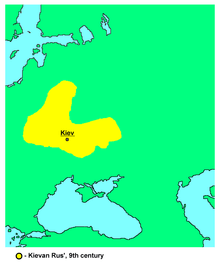Askold
Askold (Haskuldr in Old East Norse and Hǫskuldr in Old West Norse) was a prince of Kiev and founder of the first Vikings' state in the Dnieper basin.[1] According to the Nikon Chronicle Askold's name was spelled out as Oskold.[2] According to the Primary Chronicle, he along with another voivode Dir were of Rurik's clan in the 870s. That chronicle implies that they were neither his relatives nor of noble blood.

Primary Chronicle
The Primary Chronicle relates that Askold and Dir were sanctioned by Rurik to go to Constantinople (Norse Miklagård, Slavic Tsargrad). When travelling on the Dnieper, they saw a settlement on a mountain and asked to whom it belonged. They were told that it was Kiev and had been built by three brothers named Kyi, Shchek and Khoryv, who were the ancestors of the inhabitants, who were now paying tribute to the Khazars. Askold and Dir settled in the town and gathered a large number of fellow Varangians and began to rule the town and the land of the eastern Polans. The chronicle also states that they were killed by Oleg the Seer around 882,[3] yet they were buried in various places. According to the Primary Chronicle Oleg tricked and killed Askold and Dir using an elaborate scheme. Vasily Tatischev, Boris Rybakov and some other Russian historians interpreted the 882 coup d'état in Kiev as the reaction of the pagan Varangians to Askold's baptism. Tatischev went so far as to style Askold "the first martyr of Rus'".
Tale of Ragnar's Sons
According to Olof von Dalin, Askold (as Asleik Bjornson (Diar)) was the son of Björn Ironside,[4] and the grandson of Ragnar Lodbrok, a semi-legendary king of Sweden (ca. 815-830). Other researchers believe that Askold was the son of Hvitserk[5] or Hvitserk himself,[6] another son of Ragnar. Hvitserk was a contemporary of Rurik, and was said to have waged a war of conquest in Eastern Europe.
Al-Masudi
The only foreign source to mention one of the co-rulers is the Arab historian Al-Masudi. According to him, "king al-Dir [Dayr] was the first among the kings of the Saqaliba [Slavs]." Although some scholars have tried to prove that "al-Dir" refers to a Slavic ruler and Dir's contemporary, this speculation is questionable and it is at least equally probable that "al-Dir" and Dir were the same person.[7]
The theory has been voiced that in Old East Slavic it was originally "askold Dir" and not "Askold i Dir" as it is known from the Primary Chronicle. K.J.Erben believed that the word askold or oskold was derived from Old Norse óskyldr meaning strange, so there was probably a ruler of Kiev called Dir by the Slavs and the Varangians called him something like "óskyldr Dyri"—stranger Dir. The Varangians of Kievan Rus later forgot the meaning of óskyldr so Nestor wrote about two rulers of Kiev — about Askold and Dir.[8]
Facts and records
The Rus' attack on Constantinople in June 860 took the Greeks by surprise, "like a thunderbolt from heaven," as it was put by Patriarch Photios in his famous oration written for the occasion. Although the Slavonic chronicles tend to associate this expedition with the names of Askold and Dir (and to date it to 866), the connection remains tenuous. Despite Photius' own assertion that he sent a bishop to the land of Rus' which became Christianized and friendly to the Eastern Roman Empire, most historians discard the idea of Askold's subsequent conversion as apocryphal.
A Kievan legend identifies Askold's burial mound with Uhorska Hill, where Olga of Kiev later built two churches, devoted to Saint Nicholas and to Saint Irene. Today this place on the steep bank of the Dnieper is marked by a monument called Askold's Grave.
Legacy
- Russian screw frigate Askold (1854) (see List of Russian steam frigates)
- Russian cruiser Askold (1900)
See also
External links
- Guide to Askold's Grave
- Askold at Find a Grave
- Yasterbov, O. The reign of the princes Askold and Dyr: beginnings of the mighty Kyivan state. Day. 29 November 2005. (in English)
References
- Kotlyar, M. Askold. Small Dictionary of History of Ukraine. "Lybid". Kiev 1997
- Kotlyar, M. Prinices of Kiev Kyi and Askold. Warhitory.ukrlife.org. 2002
- Many scholars believe the conquest of Kiev took place a generation later; see Oleg of Novgorod for discussion of the controversy surrounding this date.
- Von der Chronistik zur modernen Geschichtswissenschaft: Die Warägerfrage in der russischen, deutschen und schwedischen Historiographie (Veroffentlichungen Des Osteuropa-instituts Munchen, Band 5) Taschenbuch – 1. Januar 2000. p. 398.
- Adolf Stender-Petersen, Heinrich Bach. Varangica. 1953, p. 207
- Войтович Л.В. Чи був Рагнар Лодброк на руських землях? // Україна в Центрально-Східній Європі. — Вип. 16. — К., 2016. C. 93-107.
- Golden, P.B. (2006) "Rus." Encyclopaedia of Islam (Brill Online). Eds.: P. Bearman, Th. Bianquis, C.E. Bosworth, E. van Donzel and W.P. Heinrichs. Brill.
- The interpretation of name Oskold/Askold is mentioned in the K.J.Erben's translation of the Primary Chronicle into Czech language.
| Preceded by uncertain |
Princes of Kiev | Succeeded by Oleg of Novgorod |